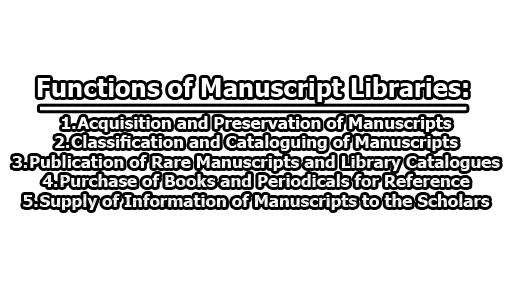Manuscript Library:
A manuscript library is a collection of handwritten or hand-copied documents, usually on parchment or paper, that are preserved for their historical, cultural, or literary significance. Manuscript libraries may also contain printed materials and other types of media, but their primary focus is on the preservation and study of manuscripts. Manuscript libraries can be found in many different types of institutions, including universities, museums, archives, and libraries. Some of the most famous manuscript libraries in the world include the British Library in London, the Bibliothèque nationale de France in Paris, and the Vatican Library in Rome. The collections within a manuscript library can vary widely in terms of their subject matter and time period. Some manuscript libraries may focus on a particular region or time period, while others may collect manuscripts from a wide range of cultures and historical periods. Manuscript libraries are important resources for scholars and researchers in a variety of fields, including history, literature, art history, theology, and linguistics. They provide access to primary source materials that can offer unique insights into the past and can help scholars to better understand the cultural, social, and intellectual developments of different historical periods. In the rest of this article, we are going to know about the functions of manuscript libraries, changing role of the manuscript librarian, preservation and conservation of manuscripts.
Functions of Manuscript Libraries:
Here are the functions of manuscript libraries explained in detail:
1. Acquisition and Preservation of Manuscripts: Manuscript libraries are responsible for acquiring and preserving manuscripts to ensure their longevity and accessibility to future generations. They often work with individuals, organizations, and institutions to acquire manuscripts through donations, purchases, or loans. Once acquired, they use specialized techniques and technologies to preserve the manuscripts, such as temperature and humidity control, restoration, and digitization.
2. Classification and Cataloguing of Manuscripts: Manuscript libraries also classify and catalog their collections to facilitate access and use by researchers and scholars. This involves assigning a unique identifier to each manuscript and creating detailed descriptive records that include information about the content, author, date, and physical characteristics of the manuscript. This information is then made available through library catalogs and online databases.
3. Publication of Rare Manuscripts and Library Catalogues: Manuscript libraries often publish rare manuscripts and library catalogs to make them accessible to a wider audience. This can include publishing facsimile editions of rare manuscripts, creating online digital collections, and producing scholarly editions of manuscripts with critical introductions and annotations.
4. Purchase of Books and Periodicals for Reference: In addition to manuscripts, manuscript libraries may also purchase books, periodicals, and other reference materials to support research and scholarship in their respective fields. This includes acquiring current and historical literature on the subjects represented in their manuscript collections, as well as materials on archival and bibliographic practices.
5. Supply of Information on Manuscripts to the Scholars: Manuscript libraries also serve as a resource for scholars and researchers by providing information and access to their collections. This includes responding to reference inquiries, providing access to manuscripts for study and research purposes, and offering guidance on the use of specialized research tools and techniques.
In summary, Manuscript libraries play a vital role in preserving and providing access to historical and cultural materials that are essential to advancing knowledge and understanding in a variety of fields.
Changing Role of the Manuscript Librarian:
The role of the manuscript librarian has evolved over time, reflecting changes in the field of librarianship and the changing needs of researchers and scholars. Here are some of the ways in which the role of the manuscript librarian has changed:
- Emphasis on Digital Access: With the increasing use of technology and digital resources, manuscript librarians have increasingly focused on providing access to their collections through digital means. This includes digitizing manuscripts and making them available online, as well as creating digital finding aids and other tools to facilitate research and scholarship.
- Interdisciplinary Collaboration: As scholarship has become more interdisciplinary, manuscript librarians have increasingly worked with researchers and scholars in a variety of fields, including history, literature, art history, and cultural studies. This has required them to develop a broader range of expertise and to collaborate with other professionals in related fields.
- Advocacy for Preservation: Manuscript librarians have become strong advocates for the preservation of historical and cultural materials, both in their own collections and in other archives and libraries. This includes promoting best practices for preservation and conservation, as well as advocating for increased funding and support for preservation efforts.
- Outreach and Engagement: Manuscript librarians have increasingly focused on outreach and engagement with the broader community, including students, educators, and the general public. This includes developing educational programs, exhibitions, and other public events that showcase their collections and promote the value of archives and libraries as cultural institutions.
- Leadership and Management: As libraries and archives have become more complex and diverse, manuscript librarians have increasingly taken on leadership and management roles. This includes overseeing budgets, staffing, and strategic planning, as well as developing policies and procedures to ensure the effective management and preservation of collections.
Overall, the changing role of the manuscript librarian reflects the evolving nature of librarianship and the importance of preserving and providing access to historical and cultural materials in the digital age.
Preservation and Conservation of Manuscripts:
Preservation and conservation of manuscripts are crucial activities undertaken by manuscript libraries to ensure the longevity and accessibility of historical and cultural materials. Here are some of the key aspects of manuscript preservation and conservation:
a. Environment: Manuscript libraries work to maintain a stable and appropriate environment for their collections, including temperature and humidity control, lighting, and air quality. This helps to prevent damage from mold, pests, and other environmental factors that can cause deterioration and decay.
b. Handling and Storage: Manuscript libraries also take great care in handling and storing their collections. Manuscripts are often stored in acid-free folders and boxes and are handled with gloves to prevent damage from oils and sweat on the skin.
c. Treatment and Repair: Manuscript conservators use specialized techniques and materials to repair and stabilize damaged or deteriorated manuscripts. This can include washing, deacidification, mending tears and holes, and reattaching loose pages or bindings.
d. Digitization: Many manuscript libraries are also digitizing their collections to provide digital access to their materials while reducing physical handling and exposure to light. Digitization can also provide an additional layer of preservation by creating a backup copy of the manuscript.
e. Disaster Planning: Manuscript libraries also develop disaster plans and emergency response protocols to minimize damage in the event of a natural disaster or other unforeseen events. This includes measures such as offsite storage and backup of digital files.
f. Education and Outreach: Manuscript libraries also engage in education and outreach efforts to raise awareness about the importance of manuscript preservation and conservation, and to promote best practices among researchers, scholars, and the broader community.
Finally, the preservation and conservation of manuscripts are critical activities undertaken by manuscript libraries to ensure the longevity and accessibility of historical and cultural materials for future generations.

Library Lecturer at Nurul Amin Degree College










